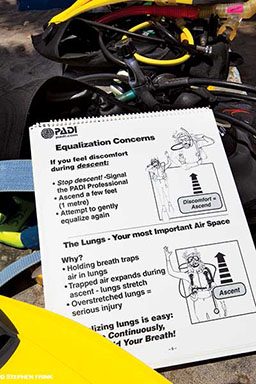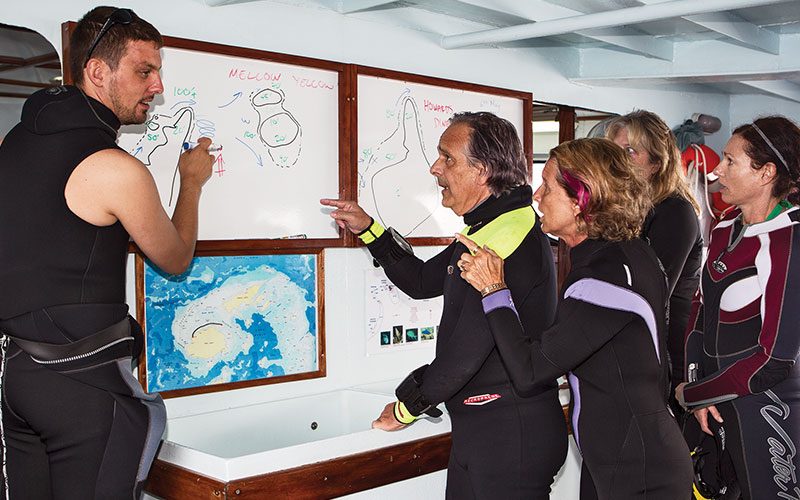Establishing a culture of dive safety is central to the mission of Divers Alert Network. Such a culture requires collective effort, and DAN intends to promote a discussion with the recreational diving community at large to advance safety and improve the diving experience.
The mantra of individual responsibility seems to ignore the very real social context of diving, a sport that is rarely practiced alone. In addition to one’s fellow divers, a dive incident may involve training agencies, dive operators, dive resorts, travel agencies, dive shops, medical and scientific organizations, equipment manufacturers and/or the media. Most incidents are attributed to human error, and calls to raise individual awareness are the remedies most often suggested by those concerned with safety.
While individual errors are a perennial issue in dive safety, it is also important to consider the role of social context in diving accidents and to promote appropriate social interventions, which may be more effective than interventions focusing exclusively on individual divers. To promote dive safety, we need to review the current safety culture (or lack thereof) in recreational diving as well as the role of individual divers and other constituents of the diving community.
We ask you to participate in this effort and provide your view of what constitutes a culture of dive safety. DAN will take this conversation to dive shows, meetings and social media, but we intend to initiate the dialogue in this column. To do so we invited three distinguished, independent dive leaders to provide their insights.
What does “recreational diving culture” mean to you?
Jill Heinerth: Sport diving is a community made up of many different subcultures. These small groups of divers are knitted together by their shops, clubs, charter operators or perhaps agency affiliations. Some of these tribes are known for their technical expertise, their great trips or safe operations. Others are tagged for aggression, cockiness or exclusivity. If you’ve been diving long enough, you’ll find that people drift in and out, switch sides and change their behaviors. Sometimes change is brought on by the wisdom of experience, sometimes through the example of great leadership and other times influenced by the shocking impact of witnessing an incident or tragedy.
John Lippmann: The diving culture can create unlikely friendships between individuals who lead totally different lives and would otherwise have little opportunity or interest in interacting. Such friendships can become strong through the trust and varying levels of reliance that can develop between dive buddies. However, as with many of such groups, cliques can develop. These are sometimes necessary for group focus, but they can also be divisive.
Alessandro Marroni: I strongly believe recreational diving culture means awareness, education, common sense and respect for the underwater realm as well as for the fellow divers. Unfortunately, achieving these ends requires characteristics that are ingrained in divers through their cultures and experiences on the one hand and on the other hand acquired through study, attention, and the learned ability to evaluate and prevent risk. The first thing to be aware of is that diving takes place in the water, in which we humans would not survive unless we adopted special measures and acted not only with passion and curiosity but also with competence and prudence.
What are characteristics of a safety-aware diver?
Marroni: Safe divers have the same passion to understand the safety limitations of diving as they do for underwater photography, fish-watching or the simple enjoyment of exploration. They also remain aware of other divers, including their needs and the possible risks they represent. Much too often poorly arranged buddy teams or diving groups can lead to catastrophic events that could easily have been prevented by more careful selection and predive checks.
Lippmann: A “safety-aware” (or more appropriately termed “safety-prepared”) diver would generally possess a variety of traits. These include a strong sense of self-preservation and self-responsibility, keenness to learn about pertinent risks and an awareness of his or her own physical, mental and medical health. Such divers seek relevant information about the site and potential associated hazards and are also prepared to abort a dive if necessary without being swayed by peer group pressure to take unacceptable risks.
Heinerth: In my opinion, a safety-aware diver is one who is fully engaged in his or her participation in diving. A safety-aware diver is one who looks at a given dive and asks: “Am I fully capable of self-rescue in this scenario, and am I fully capable and willing to execute a buddy rescue if needed?” A safe diver would enter the water only if each answer was an unequivocal “yes.”

What is the role of training agencies in shaping and disseminating a culture of safety?
Lippmann: Under their certification umbrella, they have the greatest influence on dive professionals. It is important that the agencies make their instructors and divemasters champions of dive safety, monitor their work and provide appropriate support in implementing the culture of safety. Those instructors who significantly or repeatedly breach reasonable safety standards need to be sanctioned appropriately.
The PADI “Responsible Diver” Campaign and the campaign to educate divers to ascend slowly and do safety stops are great examples of the important role that agencies can play in educating divers about key safety issues.
Heinerth: Training agencies have the opportunity to set the ground rules right from the beginning and guide divers to recognize that the general safety rules have been developed from practical experiences. One instructor who slips through the cracks without following standards can affect hundreds of future divers, who can also move on to affect another generation of divers. Maintaining high standards is critical to nurturing a consistent climate of safe diving practices.
Marroni: The commercial need to ensure expansion for the recreational diving industry has at times promoted misconceptions that activities in and under the water present little or no risk. I believe training agencies may be pivotal in producing changes by introducing the hazard identification and risk assessment (HIRA) components into their training programs to increase both the safety and the appeal of the sport.
How can dive operators contribute to the culture of dive safety?
Heinerth: These days operators are under increased competition to offer the best adrenaline-laced experiences. But I learned early that enthusiasm is infectious. If you love what you are doing, then your clients will love their experiences with you. There is wonder and satisfaction just being underwater. It’s great if you get blessed with a view of stunning manta ray, but it can be just as exciting to see a jawfish with a mouthful of eggs. Dive satisfaction doesn’t require great depths or unnecessary risks.
Marroni: Many dive operators are not aware of the risks involved or their responsibilities toward their clients. They may not pay enough attention to their clients’ skills or fitness levels, environmental and technical safety, dive boat safety, tank refill stations, etc.
Lippmann: Dive operators have the obligation to ensure that their equipment is well-maintained, that their staff members are well informed, competent and vigilant, and that divers are well matched for the sites they dive. If we don’t receive a sufficiently safe level of service from the dive operators we pay to dive, we should have little hesitation to look elsewhere.

How can the culture of dive safety be promoted?
Lippmann: Incident reporting and analysis provide strong tools on which to base relevant accident-prevention protocols. DAN has a key role to play here, and the diving community is better served if it helps DAN collect information on diving incidents and accidents so they can help guide training strategies and diving practices. Unfortunately, in some places there is a tendency to withhold important information about accidents for fear of legal or commercial repercussions. It would be great if this would change.
Heinerth: As a young diver in Tobermory, Canada, I took a class from a great role model named Dale McKnight. Our class worked hard for days, practiced skills and made plans to go on the deepest dive (and first decompression dive) of our lives. We were on the boat heading to the site when Dale told us that we had done such a great job that he would reward us with an extra 10 feet of depth and five more minutes of bottom time. My colleagues hooted and hollered in excitement, while I felt a deepening anxiety. With my head bowed, I quietly muttered that I did not feel ready and would sit on the boat. I was disappointed and embarrassed. Dale tried unsuccessfully to reel me back into the dive.
After a few minutes, Dale admonished the other divers for permitting him to shift a safe, organized plan into a “trust-me” dive. At first I did not understand what was happening, but I soon recognized that he was patting me on the back. I had passed his test. He taught me an important lesson: A true survivor needs to know when to be willing to turn back and call it a day.
Marroni: We can promote a culture of dive safety by transmitting love for the underwater realm while at the same time clearly explaining that the marvels of the sea do not come cheap but rather require certain basic but strict rules that help us avoid being overwhelmed by the force of natural elements.
We should spread similar messages in every course, before every dive and through every article or documentary related to diving. It is important to avoid indulging the superficial messages about the ease of diving or the misinformed, overly catastrophic “scoops” following dive injuries or fatalities. DAN has been striving to do so over the past 30 years, and I think that the results prove the efficacy of this approach.
Meet the Experts
Jill Heinerth, a pioneering underwater explorer and filmmaker, has dived deeper into caves than any woman in history. To recognize a lifetime devoted to water advocacy, she was awarded the Wyland Icon and Sea Hero of the Year awards. In recognition of lifetime achievement, the Royal Canadian Geographical Society presented Heinerth with the inaugural Medal for Exploration. Her photography and writing have been featured in prominent publications around the world.
John Lippmann is the founder of DAN Asia-Pacific (DAN AP), which he established in 1994 to improve the safety of scuba diving within the Asia-Pacific. He was chairman, executive director and director of training for DAN AP for 20 years, the editor of Alert Diver Asia-Pacific for 13 years and is currently chairman and director of research at DAN AP. An internationally recognized dive-safety expert, he has written many books and articles about dive safety. In 2007 Lippmann received an Order of Australia award for services to scuba-diving safety, resuscitation and first aid.
Alessandro Marroni, M.D., is the founder and president of DAN Europe and chairman of International DAN. He is also vice president of the European Committee for Hyperbaric Medicine (ECHM) and a lecturer and professor of hyperbaric medicine at the Universities of Belgrade, Padova, Palermo and Pisa. Marroni is the author of more than 250 scientific papers and publications on underwater and hyperbaric medicine and has been a scuba instructor since 1966.
© Alert Diver — Q4 Fall 2014